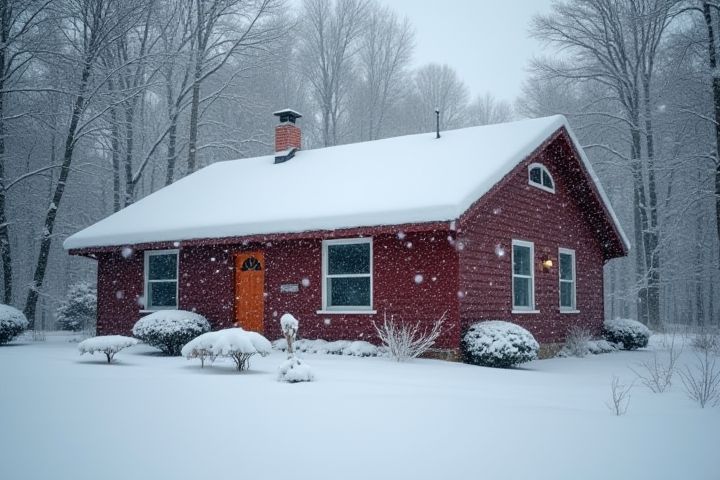
To winterize your house for cold weather, start by inspecting and sealing any gaps in windows and doors to prevent drafts. Insulating pipes, especially those in unheated areas, will help protect them from freezing. Ensure that your heating system is functioning efficiently; consider having it serviced to check the furnace and replace filters. Don't forget to drain and store garden hoses, and winterize outdoor faucets to avoid burst pipes. Finally, adding weather stripping or door sweeps can significantly improve your home's energy efficiency and comfort during the colder months.
How To Winterize A House For Cold Weather
Insulate pipes.
Insulating pipes is crucial to prevent freezing and bursting during winter, particularly in areas where temperatures can drop below 20degF (-6degC). Use foam pipe insulation or heat tape, ensuring that all exposed pipes, especially those in unheated areas like attics, basements, and garages, are adequately covered. Secure the insulation with tape or zip ties, maintaining continuous coverage to create an effective thermal barrier. Check for drafts around windows and doors, sealing any gaps to maintain a stable indoor temperature that contributes to overall pipe protection.
Seal drafts.
To effectively seal drafts in your home during winter, first inspect common areas where cold air might intrude, such as windows, doors, and electrical outlets. A significant 25% to 30% of heated air can escape through these gaps if left unaddressed. Use weatherstripping around doors and window frames, which can reduce heat loss by up to 50% when properly applied. Closing off unused rooms and applying outlet covers can further enhance your home's energy efficiency, ensuring warmth is maintained throughout the colder months.
Clean gutters.
Cleaning your gutters is crucial for winterizing your house to prevent ice dams and water damage. Clogged gutters can hold moisture, leading to freezing and potential structural issues as temperatures drop below 32degF (0degC). Ensure your gutters are free of leaves and debris, allowing meltwater to flow freely away from your foundation. Inspect your downspouts to guarantee they direct water at least 5 to 10 feet away from the base of your home, safeguarding your property throughout the colder months.
Inspect furnace.
Inspecting your furnace is crucial for ensuring a warm and efficient home during winter months. Begin by checking the air filters, as a clogged filter can reduce airflow and efficiency by up to 15%. Next, examine the ductwork for any leaks; sealing these can improve heating efficiency by as much as 20%. Finally, schedule a professional tune-up to inspect key components like the heat exchanger, ensuring your furnace operates safely and effectively throughout the cold season.
Reverse ceiling fans.
To effectively winterize your house for cold weather, adjust your reverse ceiling fans to rotate clockwise. This setting helps to circulate warm air accumulated near the ceiling down to floor level, enhancing heat distribution throughout the room. Ensure that the fan's speed is set to low to create a gentle updraft, preventing any discomfort from a draft while maximizing warmth. Regularly maintaining your ceiling fan, including cleaning and checking for proper operation, can ensure optimal performance during the winter months.
Check roof integrity.
Inspect the roof for missing or damaged shingles, as these can lead to leaks and further damage during harsh winter weather. Ensure that gutters and downspouts are clear of debris, allowing for proper drainage to prevent ice dams from forming. Consider adding insulation to the attic, which helps maintain consistent temperatures and prevents ice buildup on the roof. An assessment by a professional roofer can provide insights into any underlying issues that need addressing before temperatures drop significantly.
Replace air filters.
Replacing air filters is essential for maintaining optimal indoor air quality during winter months. Standard 1-inch air filters typically need replacement every 1 to 3 months, while HEPA filters can last up to 6 months depending on usage. A clean air filter improves HVAC efficiency, potentially saving you 5% to 15% on energy bills. Ensuring your filters are in top condition can significantly enhance the warmth and comfort of your home.
Insulate windows.
Insulating your windows is essential for reducing heat loss during winter months, with studies suggesting that poorly insulated windows can account for up to 25% of energy loss in a home. Use window film insulation kits, which are easy to apply and can improve thermal resistance by up to 90%, effectively minimizing drafts. Caulking gaps and installing weatherstripping around window frames can further enhance insulation and help maintain an indoor temperature of around 68degF. Consider adding insulated curtains or thermal blinds, which can reduce heat transfer through glass by an additional 30%.
Trim tree branches.
Trimming tree branches is crucial for winterizing your house, as heavy snow and ice can cause weak limbs to break and damage your roof or siding. Aim to remove branches that are within 10 feet of your home, ensuring they won't pose a threat when laden with winter precipitation. Use proper pruning techniques by cutting at a 45-degree angle just above a bud, which encourages healthy regrowth and reduces the risk of disease. Regularly maintaining your trees not only protects your property but also enhances the overall aesthetic of your landscape during the colder months.
Drain outdoor faucets.
To winterize your house effectively, start by draining outdoor faucets to prevent freezing and potential pipe bursts. First, turn off the water supply to each faucet, usually found in the basement or crawl space. After shutting off the supply, open the faucet to drain any remaining water and alleviate pressure in the pipes. Consider installing frost-proof faucets or using insulated covers for added protection, ensuring your plumbing remains intact throughout the winter months.
